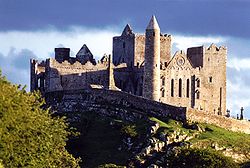St. Patrick proceeded through Gowran into Ossory; here he erected a church under the invocation of St. Martin, near the present city of Kilkenny, and enriched it with many precious relics which he had brought from Rome. It was in Leinster, on the borders of the present counties of Kildare and Queen’s, that Odhran, St. Patrick’s charioteer, attained the martyr’s crown. The chieftain of that district honored the demon-idol, Crom Cruach, with special worship, and, on hearing of that idol being cast down, vowed to avenge the insult by the death of our apostle. Passing through the territory, Odhran overheard the plot that was being organized for the murder of St. Patrick, and as they were setting out in the chariot to continue their journey, asked the saint, as a favor, to take the reins, and to allow himself, for the day, to hold the place of honor and rest. This was granted, and scarcely had they set out when a well-directed thrust of a lance pierced the heart of the devoted charioteer, who thus, by changing places, saved St. Patrick’s life, and won for himself the martyr’s crown.

Cashel of the Kings in 1986 (in country Tipperary)
St. Patrick next proceeded to Munster. As usual, his efforts were directed to combat error in the chief centers of authority, knowing well that, in the paths of conversion, the kings and chieftains would soon be followed by their subjects. At “Cashel of the Kings” he was received with great enthusiasm, the chiefs and Brehons and people welcoming him with joyous acclaim. While engaged in the baptism of the royal prince Aengus, son of the King of Munster, the saint, leaning on his crosier, pierced with its sharp point the prince’s foot. Aengus bore the pain unmoved. When St. Patrick, at the close of the ceremony, saw the blood flow, and asked him why he had been silent, he replied, with genuine heroism, that he thought it might be part of the ceremony, a penalty for the joyous blessings of the Faith that were imparted. The saint admired his heroism, and, taking the chieftain’s shield, inscribed on it a cross with the same point of the crozier, and promised that that shield would be the signal of countless spiritual and temporal triumphs.
Our apostle spent a considerable time in the present County of Limerick. The fame of his miracles and sanctity had gone before him, and the inhabitants of Thomond and northern Munster, crossing the Shannon in their frail coracles, hastened to receive his instruction. When giving his blessing to them on the summit of the hill of Finnime, looking out on the rich plains before him, he is said to have prophesied the coming of St. Senanus: “To the green island in the West, at the mouth of the sea [i.e., Inis-Cathaigh, now Scattery Island, at the mouth of the Shannon, near Kilrush], the lamp of the people of God will come; he will be the head of counsel to all this territory.” At Sangril (now Singland), in Limerick, and also in the district of Gerryowen, the holy wells of the saint are pointed out, and the slab of rock, which served for his bed, and the altar on which every day he offered up the Holy Sacrifice. On the banks of the Suit, and the Blackwater, and the Lee, wherever the saint preached during the seven years he spent in Munster, a hearty welcome awaited him. The ancient Life attests: “After Patrick had founded cells and churches in Munster, and had ordained persons of every grade, and healed the sick, and resuscitated the dead, he bade them farewell, and imparted his blessing to them.” The words of this blessing, which is said to have been given from the hills of Tipperary, as registered in the saint’s Life, to which I have just referred, are particularly beautiful:
A blessing on the Munster people —
Men, youths, and women;
A blessing on the land
That yields them fruit.
A blessing on every treasure
That shall be produced on their plains,
Without any one being in want of help,
God’s blessing be on Munster.
A blessing on their peaks,
On their bare flagstones,
A blessing on their glens,
A blessing on their ridges.
Like the sand of the sea under ships,
Be the number in their hearths;
On slopes, on plains,
On mountains, on hills, a blessing.
Patrick’s ministry covered a period of 60 years. He founded 365 churches, and a school arose beside each church. The schools were frequently called monasteries. The monasteries of St. Patrick’s day were nothing like the Roman Catholic monasteries of later years. They were not isolated from the world – no vows were taken and the clergy were always allowed to marry. The monasteries were associations of studious men, who occupied their time in transcribing the Scriptures, in cultivating such sciences as were then known, and instructing the young. They were colleges in which the youth were trained for the work of the home ministry and the labors of the foreign mission-field.
